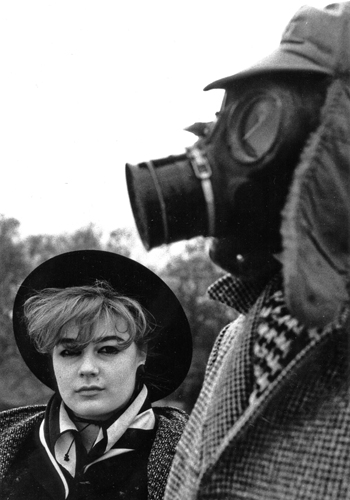| |
When Mick Sinclair left the Funboy Five
it was to pursue other studio-based projects, one of which became Das
Boomerang. 'Studio-based' was usually a euphemism for a Teac 3340
reel-to-reel tape machine, a six channel mixing desk and a Revox A77
tape recorder set up in Mick's bedroom in north London.
During
1982, he created the backing tracks to what became a version of Leonard
Cohen's song Suzanne, albeit one that would be, other than for the
words, unrecognisable from the original. The search for a singer to
provide vocals concluded with Dinah Mulholland, who Mick had met as
part of Worldbackwards, who had released an album called Flesh. One
major problem for Dinah was that her vocal had to go onto the parts of
the backing track that had no more than percussion, leaving nothing to
pitch her voice to. Nonetheless, the recording was completed and mixed
in various forms, complete with double-speed trumpet solo.

Knowing this was just the sort of
thing to
liven up the charts, Mick played 'Suzanne' to Phonogram's then A&R
man, Ashley Goodall and was offered free time in Phonogram's 24-track
studio to 'record it properly'. Asked how long such a thing might take,
Mick replied 'three days' but was offered two by the intrigued but
doubtful Goodhall.
The two days eventually became one
and Mick,
aware of time restraints and planning to be creative with Phonogram's
mixing desk, took the homemade backing track to the studio to allow
more time for Dinah's vocals and additional percussion, in the form of
a Phonogram fire extinguisher being hit with a screwdriver,to be added.
The trumpet part was also
re-recorded, again at double speed, which obviously meant the tape
being played at half speed, much to the shock of the engineer ('we had
Soft Cell in last week, they didn't do that').

As far as Mick was concerned, the
creative part
of recording was the mixing. In this instance, the mix featured Mick
further antagonising the engineer ('Kool and the Gang were nothing like
this') by plugging his little Dr Rhythm drum machine into the
48-channel mixing desk and playing it live as the mix was being done,
adding the heavily-reverbed fast snare crashes (for want of a better
term) to the track.
Even though the engineer
eventually admitted the drum machine sounded good, the track could have
done with an entire day just to develop ideas at the mixing stage. As
it was, it was the start of an idea, not the completion of one and,
unsurprisingly, Ashley Goodall decided enough was enough and handed the
tape back to Mick.
A few months later, Dave Barker of
Glass Records
decided to include 'Suzanne' on Shadow and Substance: The Wonderful
World of Glass Volume 2, released in 1984. There it appeared alongside
such luminaries as Bruce Pavitt, Ronaldo and the Loaf, the Jazz Butcher
and Half Japanese.
|
| |
And there it
effectively rested in peace... which is not to say
that one day the properly mixed version of Suzanne may appear (Leonard
Cohen permitting, of course).

Above photos by Steve Rapport, taken on a
very cold
day on Chelsea Bridge which crosses the Thames, a river that Mick
Sinclair would later write a book about. In 2018, Das Boomerang unexpectedly reappeared with a reimagining of the 1980 Funboy Five single:
|
|